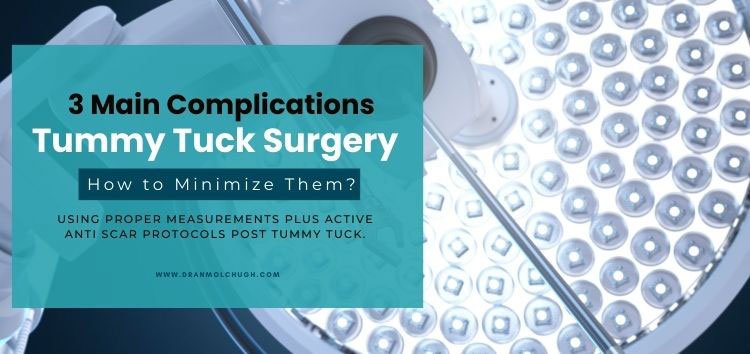
3 Main Complications of Tummy Tuck Surgery and How to Minimize Them?
3 Main Complications of Tummy Tuck Surgery
Infection- Infection can occur in some cases that can delay healing, usually not life threatening.
In order to remove extra skin and fat and tighten the abdominal muscles, the surgeon makes an incision in the lower abdomen. The underlying tissues are then divided. There is a chance of infection whenever the skin is cut.
After a stomach tuck, redness, swelling, warmth, pain, and discharge or drainage from the incision site can all be indicators of an infection. Additionally, the patients may get a fever or chills.
It’s crucial to adhere to the recommended post-operative care instructions to help lower the risk of infection after a belly tuck, which may include:
- Maintaining the incision site clean and dry;
- taking the prescribed antibiotics;
- abstaining from hard exercise and heavy lifting;
- and reporting any infection symptoms to the surgeon as soon as feasible.
When an infection occurs, quick treatment is crucial to preventing the infection from spreading and leading to additional difficulties. Antibiotics and/or drainage of the diseased region are possible forms of treatment.
We give good antibiotic cover before, during and after tummy tuck to lower the risk of infection plus maintain complete sterility in OT and post procedure care.
Seroma – Seroma or fluid collection can occur after tummy tuck.
After a tummy tuck procedure, a seroma is one potential complication that might develop. It is an accumulation of clear fluid under the skin in the abdominal region where the surgery was done.
In order to remove extra skin and fat during a stomach tuck procedure, the surgeon makes a space between the abdominal muscles and skin. The body begins to manufacture fluid in the region where the pocket was formed after surgery. In rare instances, this fluid is not reabsorbed by the body and instead builds up beneath the skin, causing a seroma to form.
Swelling, pain, and an apparent lump or protrusion in the abdomen are all signs of a seroma. Typically, a physical examination or imaging tests like an MRI or ultrasound can diagnose it.
Seromas are often treated by using a needle or catheter to drain the fluid. The fluid may need to be drained more than once in some circumstances. Compression clothing and pressure dressings may also be utilised, in addition to drainage, to aid in preventing a seroma from recurring.
That is why in some cases drains are used plus a special technique of suturing known as Progressive Tension Sutures decrease the risk of Seroma formation in Abdominoplasty.
Scarring – Scars can hypertrophy or can be placed too high.
Patients who have an abdominoplasty, often known as a tummy tuck, frequently worry about scarring. To remove extra skin and fat and tighten the abdominal muscles, a lengthy incision is made across the lower abdomen.
The patient’s age, the condition of their skin, and the surgical technique employed can all affect the size and visibility of scarring after a belly tuck. But the surgeon will take all possible precautions to reduce scarring and make sure the incision is concealed by clothing.
The incision site will initially appear red and elevated, and the scar can be more obvious in the months immediately following surgery. The scar will eventually become flatter and lighter in colour as time goes on. The scar’s ultimate form can typically take up to 12 to 18 months to fully manifest.
It’s critical to carefully adhere to your surgeon’s post-operative recommendations in order to reduce scarring and encourage optimal healing. This can entail minimising sun exposure, keeping the incision site clean and dry, and utilising scar treatments like silicone sheeting or topical lotions as advised by your surgeon.
Although some scarring is common after a tummy tuck, it’s important to remember that every patient’s healing process is different, and there is no assurance that the procedure will leave no visible scars. Scarring normally disappears and becomes less obvious with time, and the majority of patients are happy with the cosmetic outcomes of their stomach tuck treatment.
Using proper measurements plus active anti scar protocols post Tummy tuck.